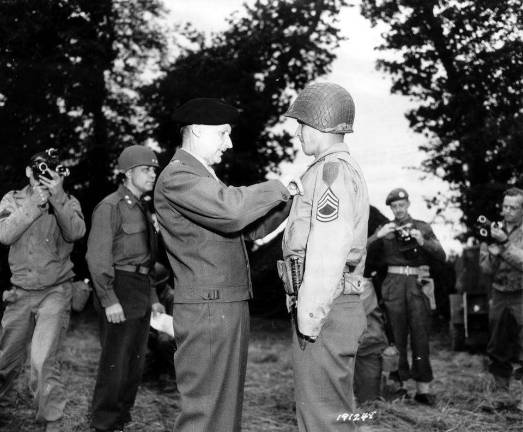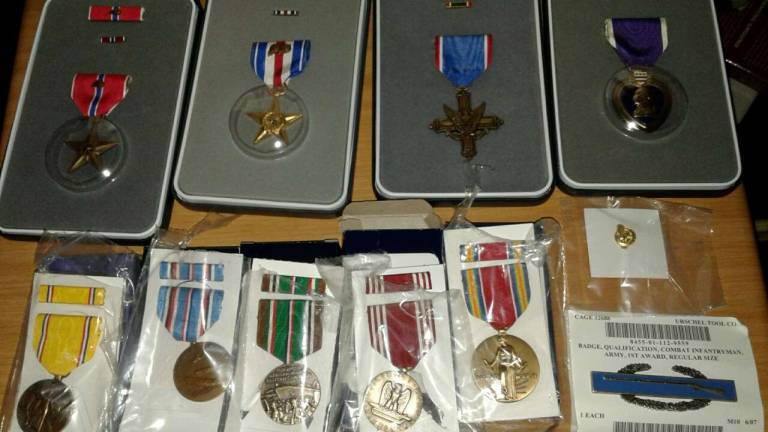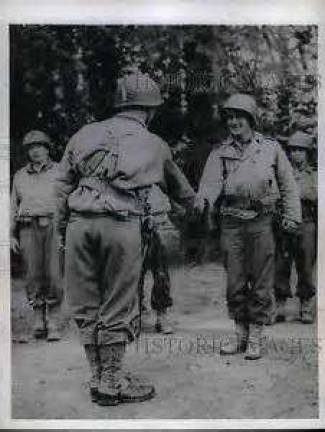Son revives amazing lost story of Philip Streczyk, D-Day hero




By Ginny Privitar
MILFORD — Ron Streczyk never got a chance to know his father.
Philip Streczyk died when Ron, now a Milford resident, was three. But thanks to the elder Streczyk’s exploits chronicled in dozens of books, Ron knows about his father’s breathtaking heroism on D-Day, followed by his death by suicide only a few years later.
“Like Spalding, Phil Streczyk paid a heavy price for his valor on D-Day,” writes John C. McManus in “A Knife in the Vitals: Omaha Beach” (World War II Magazine, Feb. 15 2017). Company commander Ed Wozenski, who also survived that bloody day, wrote of the courageous New Jersey native, “If (he) did not earn a Congressional Medal of Honor, no one did.” By Nov. 1944, when Streczyk was fighting in the Hürtgen Forest, he had logged 440 days of frontline combat. After suffering multiple wounds and dodging numerous near misses throughout the war, he was permanently evacuated with combat fatigue.”
Philip Streczyk returned home after the war and married his sweetheart, Sophie (nee Karaneuski). They had four children, daughters Mary Ann and Phyllis and sons Stanley and Ron. The family relocated to Warwick in Orange County, N.Y. But the war stayed with Streczyk.
“He could not leave the war behind,” McManus writes. “His physical wounds deeply pained him; his emotional wounds might have been worse. At night traumatic battle dreams tormented him. In 1957, Streczyk took his own life — another casualty of D-Day, albeit 13 years after the fact.”
Ron Streczyk told The Courier that, at the time McManus interviewed him in 2014, he didn’t know how thoroughly his father had been wracked by gangrene. He had been shot in the neck while fighting in the Hürtgen Forrest and refused medical treatment because he didn’t want to leave his men. With multiple wounds, he later developed severe gangrene.
Philip Streczyk died on June 25, 1958, and was laid to rest in the Church of Our Saviour Cemetery in Hamilton, N.J. Curiously, among his effects he had a Medal of Honor ribbon, but not the medal itself.
“I’m so excited and so proud to have the medals,” said Ron. “I look at the medals and the sky, and I’m saying ‘Thanks, Dad.’”
Leading men to safetyPhilip Streczyk served in the 1st Infantry Division, 2nd Battalion, 16th Regiment, Easy Company as Tech Sergeant, under Lieutenant John M. Spalding.
Philip Streczyk lived in East Brunswick, N.J., before the war and worked as a truck driver. He trained at Fort Dix and was with the 1st Division in North Africa, Italy, and France. He fought in several campaigns and was among the first to land and make it onto Omaha Beach. Many troops were pinned down and died on the beach. Instead of going straight up the beach and cliffside, Streczyk found a way lead the men up the side, in a slight ravine on a mined, steep hill covered with light vegetation that offered some protection from enemy fire.
At the top of the hill, the Americans wiped out a German stronghold and continued clearing out trenches and pillboxes and capturing prisoners until they eventually arrived in the town of Colville-sur-Mer.
Lost medalsPhilip Streczyk was awarded many medals for his heroism, including the Purple Heart, Distinguished Service Cross, the British Military Medal (pinned on him by Montgomery), and Silver and Bronze Stars. But they disappeared when another family member took them.
“Somebody in Lake Ariel called me in 2006 or ‘07 and said, ‘Hey, one of your father’s medals is on sale on eBay,’” Ron recalled. “It was sold in Florida.”
Now he is trying to get them all reissued. The task has proved somewhat difficult because of a fire at the Army’s personnel records center in St. Louis.
Besides obtaining his father’s medals, Ron is also trying to fill out lost parts of his father’s military record. So far he’s gotten 13 medals, including two Bronze Stars. But he knows his father had six, according to his discharge record. He may have had as many as four Silver Stars.
Dwight Eisenhower himself pinned Philip Streczyk with the Distinguished Service Cross on July 7, 1944, for his actions on D-Day.
The citation reads, in part:
“In the face of vicious enemy fire, Sergeant Philip Streczyk led his section across the beach. He cut through the enemy wire, led his platoon through a minefield and up a steep hill overlooking the beach and by this action opened a beach exit. He then led his section in an attack on an enemy emplacement, the fire from which had prevented the establishment of a vitally needed beachhead in that sector. In a vicious fight, Sergeant Streczyk set the example for his men in leading the attack. The destruction of this enemy strongpoint contributed materially to the success of the invasion effort. The valor, initiative and disregard for his own safety exhibited by Sergeant Streczyk exemplify the highest traditions of the military forces of the United States and reflect great credit upon himself, the 1st Infantry Division, and the United States Army.”